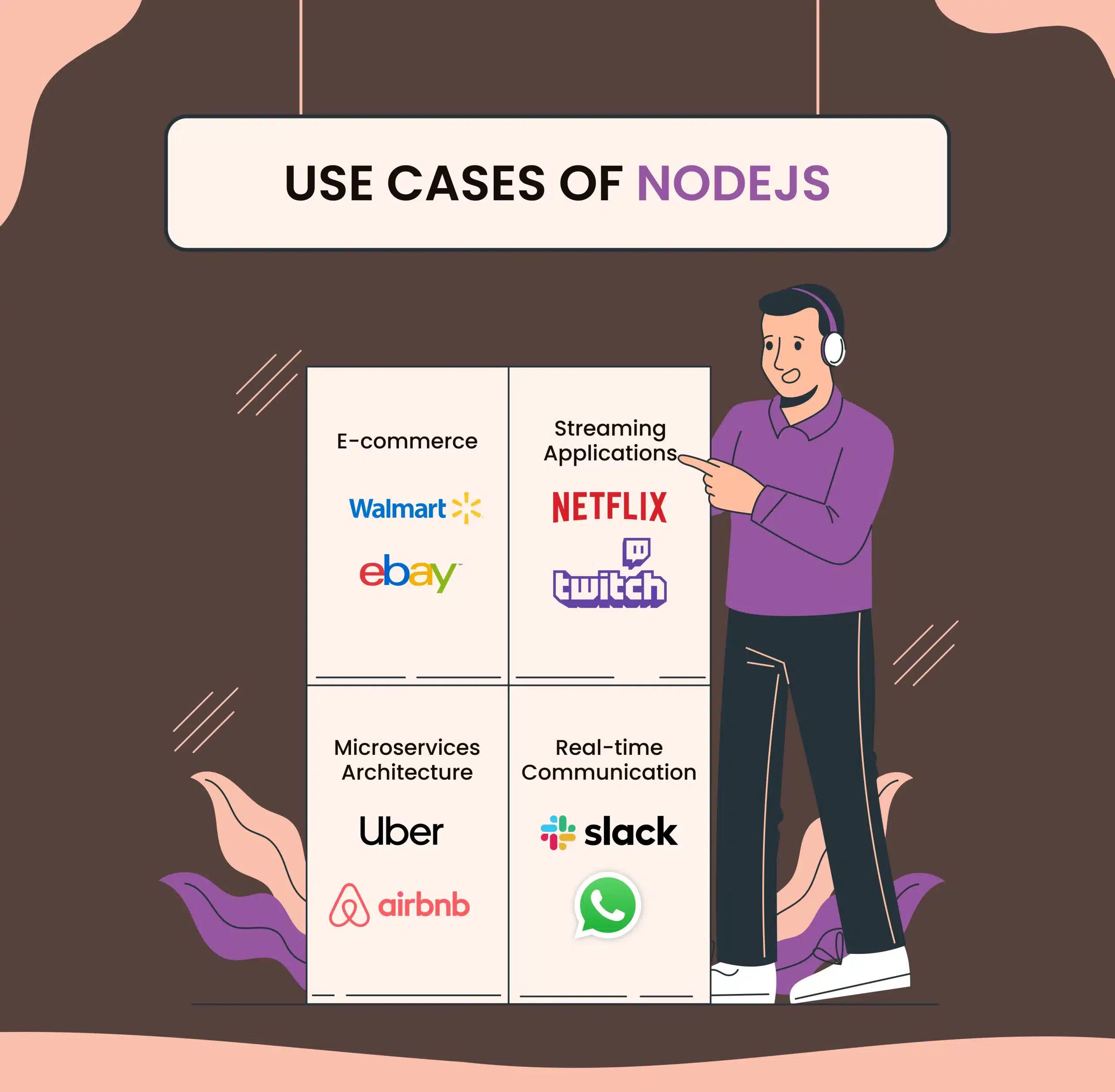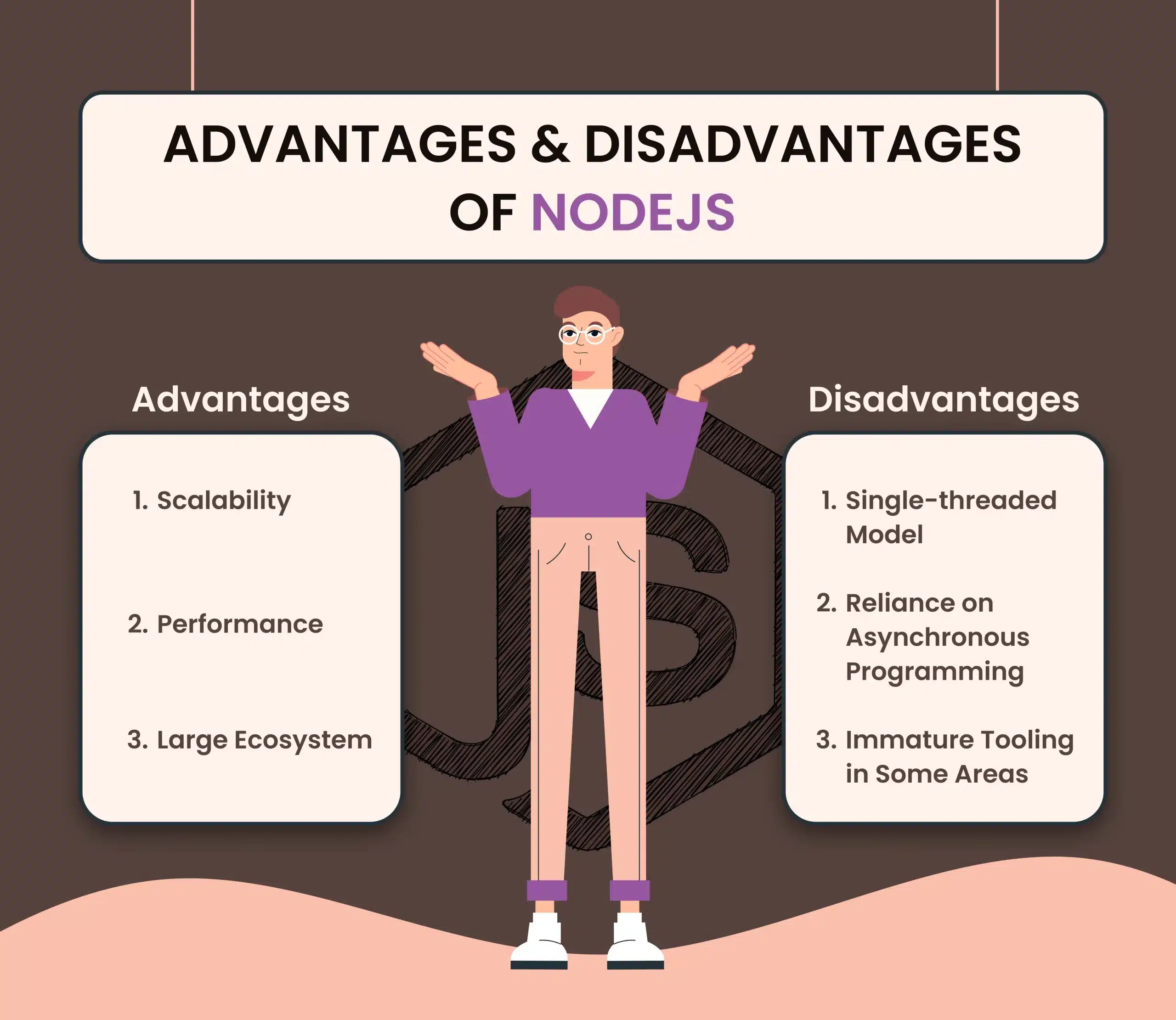Table of content
What is NodeJS? Its Features and Architecture
NodeJS is a robust and powerful runtime environment for executing JavaScript on the server-side. It offers several unique features that make it a popular choice among developers. In this section, we will explore the key features of NodeJS and delve into its architecture to understand how it works.
Event-Driven and Non-blocking I/O Model
One of the standout features of NodeJS is its event-driven and non-blocking I/O model. Unlike traditional server-side technologies that rely on blocking I/O operations, it utilizes an event-driven architecture. This means that instead of waiting for I/O operations to complete, NodeJS allows the execution of other tasks while waiting for the I/O operations to finish. This asynchronous approach enables better utilization of system resources and makes it highly efficient for handling concurrent requests.
The V8 Engine
NodeJS leverages the powerful V8 engine, developed by Google, which also powers the Chrome browser. The V8 engine compiles JavaScript code into machine code, delivering exceptional performance and speed. It utilizes just-in-time (JIT) compilation, optimizing JavaScript execution for efficient memory management and enhanced runtime performance. This allows NodeJS to handle a large number of requests with minimal resource consumption.
The Event Loop
The event loop is a crucial component of NodeJS architecture. It is responsible for managing and executing asynchronous operations efficiently. When an asynchronous task is initiated, it is added to the event loop, and NodeJS continues executing other tasks until the asynchronous task is completed. Once the task finishes, the event loop notifies the corresponding callback function, allowing developers to handle the result. This event-driven approach enables seamless handling of multiple concurrent requests, making it ideal for building scalable applications.
Single-Threaded Nature
Another characteristic of NodeJS is its single-threaded nature. Unlike traditional server-side platforms that create a new thread for each request, NodeJS utilizes a single-threaded event loop mechanism. While this may seem counterintuitive, NodeJS achieves concurrency by leveraging non-blocking I/O operations and an event-driven architecture. It allows NodeJS to efficiently handle a massive number of concurrent connections without the overhead of thread management, leading to better overall performance.
Scalability and Performance
Thanks to its event-driven, non-blocking architecture, NodeJS excels in building highly scalable and performant applications. By efficiently utilizing system resources and minimizing bottlenecks caused by blocking operations, it can handle a large number of concurrent requests with low latency. This makes it particularly suitable for real-time applications such as chat platforms, streaming services, and collaborative tools.
Real-world Use Cases of NodeJS
NodeJS has gained immense popularity due to its versatility and ability to handle large-scale applications efficiently. Let’s explore some of the real-world use cases where developers have leveraged the power of NodeJS to build innovative solutions.
E-commerce
- NodeJS has become a go-to choice for e-commerce platforms seeking high performance and scalability. Its non-blocking I/O model allows handling concurrent requests efficiently, enabling real-time inventory management, product recommendations, and seamless checkout experiences.
- Popular e-commerce platforms like Walmart and eBay have successfully adopted NodeJS to enhance their websites’ performance and deliver real-time updates to users.
Streaming Applications
- NodeJS is well-suited for handling streaming applications, where real-time data transmission is crucial. Its event-driven architecture, combined with the ability to handle multiple connections simultaneously, makes it an excellent choice for building media streaming platforms.
- Streaming giants like Netflix and Twitch rely on NodeJS to power their video streaming services and deliver uninterrupted content to millions of users worldwide.
Real-time Communication
- NodeJS is widely used for developing real-time chat applications, collaborative tools, and even multiplayer games. Its event-driven nature allows for instant message delivery and real-time updates without constant polling.
- Platforms like Slack and WhatsApp utilize NodeJS to provide seamless real-time communication experiences for their users.
Microservices Architecture
- NodeJS is a natural fit for implementing microservices architecture. Its lightweight nature, scalability, and flexibility enable developers to create independent, loosely coupled services that work harmoniously together.
- Companies like Uber and Airbnb have adopted NodeJS for their microservices-based architectures, allowing them to scale their applications dynamically and handle high loads efficiently.
Advantages and Disadvantages of NodeJS
NodeJS has gained significant popularity among developers due to its numerous advantages. However, like any technology, it also has its limitations and challenges. In this section, we will discuss the benefits of using NodeJS as well as the potential drawbacks to consider.
Advantages of NodeJS
Scalability
One of the key advantages of NodeJS is its ability to handle a large number of concurrent connections. Due to its non-blocking, event-driven architecture, it is highly efficient and can handle thousands of concurrent requests without consuming excessive resources.
Performance
It utilizes the V8 JavaScript engine, which compiles JavaScript into machine code, resulting in high-performance execution. It also employs an event-driven, non-blocking I/O model, allowing for efficient handling of I/O-intensive operations and avoiding blocking delays.
Large Ecosystem
It has a vibrant and extensive ecosystem of libraries, modules, and frameworks available through the Node Package Manager (NPM). This rich collection of tools greatly accelerates development by providing ready-made solutions for various functionalities.
Limitations and Challenges
Single-threaded Model
NodeJS uses a single-threaded event loop model, which means it executes all requests on a single thread. While this can provide high performance for I/O-intensive applications, it can be limiting for CPU-intensive tasks. Applications with heavy computation might experience reduced performance.
Reliance on Asynchronous Programming
This tech stack heavily relies on asynchronous programming to achieve non-blocking I/O. While this can lead to efficient resource utilization, it also introduces a steep learning curve for developers accustomed to synchronous programming paradigms.
Immature Tooling in Some Areas
Although the tech has a mature ecosystem, certain areas, such as debugging and profiling tools, might be less developed compared to other technologies. However, the NodeJS community continuously works on improving the tooling landscape.
While it offers many advantages for developing scalable and high-performance applications, its limitations and challenges should be carefully considered before choosing it for a project. By weighing these factors, developers can make informed decisions and leverage NodeJS effectively in their applications.
Conclusion
In conclusion, NodeJS is a powerful runtime environment for executing JavaScript on the server-side. It offers numerous advantages and has become increasingly popular among developers for building scalable web applications.
Throughout this article, we explored the basics of NodeJS, its features, architecture, and real-world use cases. We learned that it utilizes an event-driven and non-blocking I/O model, making it highly efficient for handling large volumes of concurrent requests. Its use of the V8 engine and event loop ensures optimal performance.
Happy coding with NodeJS!
And if you are a business looking to hire a NodeJS developer for your project, Supersourcing is here to help.



